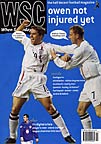 Paul Knott pays tribute to the pioneering life and times of Valery Lobanovsky
Paul Knott pays tribute to the pioneering life and times of Valery Lobanovsky
The image conjured up by Valery Lobanovsky, who died in May aged 63, was of a Slavic cousin of the Lanarkshire coalfields school of managers, glowering from the dugout. An astute and inspirational disciplinarian with a fearsome temper, he had plenty in common with Stein and Shankly. But there was also a great intellect behind the harsh exterior. Lobanovsky pioneered the use of scientific methods in coaching. Unlike many of his cerebral peers, the outcome was neither mechanical nor negative. The aim was always to complement the artistry of his players. His teams’ alliance of power with flair produced a style that significantly raised the game’s technical standards.
Lobanovsky was a winger in the 1961 Dynamo Kiev team that loosened the Muscovite grip on the Soviet title. His return as coach in 1973 removed it completely as five titles in eight seasons were secured and Lobanovsky’s hero status in Ukraine with them. That team, which won the Soviet Union’s first European trophy (the 1975 Cup-Winners Cup) and thrashed Bayern Munich in the Super Cup, was Lobanovsky’s first great one.
After a spell with the national team he returned to repeat the trick in the Eighties, cruising to another Cup-Winners Cup in 1986 with a 3-0 final win against Atlético Madrid. The common thread was Oleg Blokhin, a prodigy on whom Lobanovsky lavished particular attention. Blokhin, with his speed, grace, power and skill, represented what Lobanovsky had always wanted to be in his playing days.
He transposed the Eighties Kiev vintage, featuring Kuznetsov, Baltacha, Zavarov, Mykhailychenko, Rats and Belanov, into the Soviet team that reached the final of Euro 88. This was perhaps the closest Lobanovsky got to realising his vision of a “star team”. In his view individual stars “hinder the evolution of football, quickly losing motivation and not striving to learn what is new”. Whereas the “star team” was made up of “players with great talent who strive for perfection, understand the development of modern football and that the main things happen off the ball”. What would have been his greatest victory was denied by the only team around that had mastered this philosophy better than his own – the Dutch, with Van Basten and Gullit at their peak.
In some ways Lobanovsky won less than he ought to have, but the influence of his methods was huge. He was the first to examine seriously the effect of diet on performance. He implemented regular scientific testing of his players’ physical and psychological states and kept vast amounts of data. This was used to create programmes to maximise the fitness and technical skills essential for a system based on constant, coordinated movement.
Lobanovsky sometimes played on his renowned emphasis on science for more traditional motivational effect. Alexander Zavarov recalls being given video games at one World Cup. The players were told that these had been designed to stimulate brain-to-limb reactions and that analysis of their results would influence team selection. Hooked, the whole squad spent every spare minute playing them. Zavarov performed best and became convinced he had world-beating powers. Some time later he realised that none of the squad had been out on the town during the tournament either.
The end of the Soviet era appeared to mark the end for Lobanovsky too. Apart from his Politburo looks, he seemed steeped in the system he had deftly exploited to enable Dynamo to compete with clubs in the West. This underestimated his thirst for new ideas and his adaptability. After six years of semi-retirement he came back to build another fine Dynamo team. But despite dominating in Ukraine they again fell short of the biggest prize, freezing in 1999 against Bayern in the Champions League semi. Shevchenko and co were sold, while Lobanovsky’s health went downhill.
As ever, there was a deeper legacy. Lobanovsky had masterminded an astonishing redevelopment of Dynamo’s training camp outside Kiev, incorporating its own sophisticated medical rehabilitation centre. Coaches from all over Europe have flocked to study Koncha Zaspa since its completion in 1998. Manchester United’s new facility and the FA’s planned National Football Centre at Burton-on-Trent are just two places where Lobanovsky’s influence will be felt for years to come.
From WSC 185 July 2002. What was happening this month